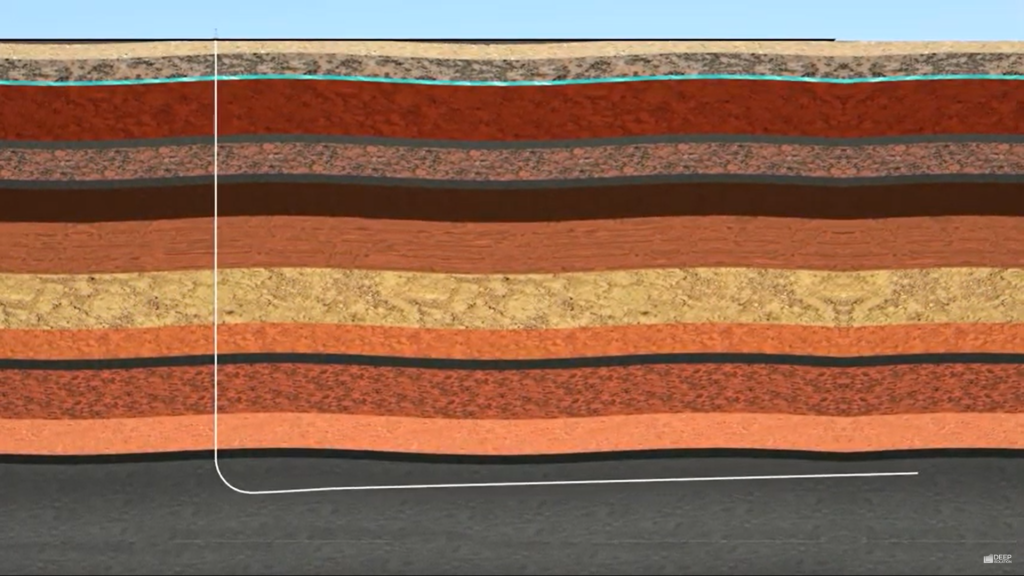Nuclear waste disposal: Why the case for deep boreholes is … full of holes
By Lindsay Krall | March 26, 2020
 An illustration of a deep borehole for nuclear waste disposal, from Deep Isolation’s concept animation video (www.youtube.com/watch?v=WeCc2RYbEQM). It would take several hundred such holes to bury all US nuclear waste from civilian reactors.
An illustration of a deep borehole for nuclear waste disposal, from Deep Isolation’s concept animation video (www.youtube.com/watch?v=WeCc2RYbEQM). It would take several hundred such holes to bury all US nuclear waste from civilian reactors.
In the budding days of the COVID-19 pandemic, President Trump idled his days away, launching random tweets about unrelated issues. One such issue was nuclear waste disposal: “Nevada, I hear you on Yucca Mountain…my Administration is committed to exploring innovative approaches – I’m confident we can get it done!”
After this particular proclamation, the nuclear expert community was left scratching its collective head. Does the president support Yucca Mountain as an eventual nuclear waste repository, or does he not? And, more puzzling, what “innovative approaches” for nuclear waste does he have in mind? Maybe he was thinking about the “waste eating” advanced reactors promoted by the US Energy Department and the private sector; maybe he was thinking about reprocessing spent nuclear fuel; or maybe he was thinking about deep boreholes for permanent waste storage.
The deep borehole concept is relatively simple and has been around since the 1950s. Rather than excavate one enormous mine like Yucca Mountain to store all US civilian nuclear waste, this solution would involve depositing nuclear waste in hundreds of narrow holes drilled into the earth’s crust.
The idea has plenty of boosters, among them a start-up called Deep Isolation, based in Berkeley, California. Founded by physicist Richard Muller and his daughter Elizabeth Muller, the company launched a Series A investment round earlier this year on the promise that it can bring the borehole concept to fruition. By leveraging the lateral drilling technology developed for tapping into shale gas deposits, the company that professes to be the “SpaceX” of nuclear waste claims to have hacked a solution for the permanent disposal of the United States’ 82,000 metric ton inventory of commercially-generated spent nuclear fuel.
Unfortunately, the proposal is full of holes.
The problem of Yucca Mountain. Ever since the 1950s, the United States has been searching for a place to bury its nuclear waste, which remains radioactive for tens of thousands of years. In 1987, against the will of Nevadans, the US Congress designated Yucca Mountain to host the nation’s spent fuel inventory through an amendment to the Nuclear Waste Policy Act. Ever since, the site has been treated as a political football. The facility was supposed to open in 1998, but far from completion, the project was dismantled in 2010. So far, the only thing that’s been built there is a five-mile exploratory tunnel.
Meanwhile, those 82,000 metric tons of spent nuclear fuel remain in temporary storage. In practical terms, that means the spent fuel is sitting at about 80 different places spread out across 35 states, stored either in pools of water or in casks made of steel and concrete.
The delays and shortcomings at Yucca Mountain have created opportunities for companies like Deep Isolation to profit from empty promises to deliver “alternative solutions.”
The borehole business model. By pledging to streamline the process of disposing spent nuclear fuel, Deep Isolation has already amassed over $14 million in venture capital. To save nuclear plants from shipping their waste to a centralized repository 2,000 miles away, the company conceives to bury the waste more or less on-site at each power plant in nearly horizontal underground holes.
Even though hundreds of boreholes will be required to house the nation’s spent fuel inventory, this option is said to be inexpensive, relative to Yucca Mountain. Deep Isolation cites a lower-limit cost of $2 million to drill one hole but suggests that the approach will save money overall by eliminating things like further interim waste storage, transportation, and much of the necessary construction workforce. Confronted with an economies-of-scale argument that would favor a few, large-capacity facilities, the company markets its approach as “modular,” so that the revenue generated from the completion of one easily-replicated, generic borehole can finance the development of subsequent boreholes.
A supposedly irrefutable safety case accompanies these seemingly excellent financials. Unlike the Yucca Mountain repository, boreholes would be sited below the water table, at depths ranging from 600 meters to 2 kilometers, in sedimentary rock formations. The disposal zone would consist of or be overlain by shale rock formations, which contain ductile clay minerals that can heal any fractures that would otherwise facilitate the flow of water—a potential hazard—to and away from the waste. Simple tests, such as analyses of natural chlorine isotopes, show that the water in these formations is millions of years old. This, Deep Isolation hopes, will convince stakeholders that the system is impenetrable, with negligible risk for contamination of nearby aquifers.
A watertight plan? Long before Deep Isolation announced its hack, the Energy Department had concluded in the 1980s that disposal of spent nuclear fuel in boreholes drilled to depths of roughly 10 kilometers was not an attractive alternative to mined repositories. In the years following, the US Nuclear Waste Technical Review Board, the US Nuclear Regulatory Commission, and waste management organizations of Sweden, the United Kingdom, and Canada reviewed concepts for shallower boreholes, with waste emplaced at depths ranging between 3 kilometers and 5 kilometers. Similar to the Energy Department study, these reviews concluded that borehole disposal would require decades of research, design, and development, which—even if successful—did not promise safety margins superior to a well-sited, deep-mined repository. A more recent study that several colleagues and I authored found that Deep Isolation’s even shallower boreholes, at depths of around 2 kilometers or less, would be plagued by the same problems and that suitable borehole disposal sites are, in fact, geographically scarce.
Many challenges to the viability of borehole disposal stem from the limit that modern drilling techniques impose on borehole diameters. Although the precise borehole geometry is dependent on location-specific geologic variables, deeper boreholes generally necessitate smaller diameters. Such a limitation has implications both in terms of the barrier system that surrounds the nuclear fuel and in terms of the ability to fully characterize the geology of the disposal site.
To accommodate canisters whose diagonal cross-section has a length of 30 centimeters, the diameter of Deep Isolation’s curving boreholes must be larger than 40 centimeters. Since this exceeds the 22-centimeter standard for oil and gas extraction, the technical feasibility of Deep Isolation’s drilling scheme remains unclear. But if it is feasible, then a 40-centimeter diameter borehole would restrict the thickness of the canister walls to about one centimeter. As compared to deep-mined repositories, which could accept canisters with walls thicker than 5 centimeters, thin-walled canisters will have adverse safety consequences for the workers who will load the waste into the boreholes. Therefore, potential worker exposures to and environmental releases of radioactivity during canister loading warrants careful consideration.
For instance, gamma radiation emitted by spent fuel can penetrate a canister wall and expose operators to radiation. The thick-walled canisters destined for deep-mined repositories will attenuate a significant portion of this penetrating radiation, but the thin-walled canisters inherent to borehole disposal will have negligible shielding capability.
The sheer number of canisters will pose further challenges. Canister designs for mined repositories will have a capacity of at least four spent fuel assemblies, whereas borehole canisters will each contain only one assembly. Lowering hundreds of thousands of flimsy canisters into hundreds of narrow boreholes in a safe, timely fashion will be tricky, to say the least. If a canister is punctured or becomes stuck during this phase, then the risk to operators and the environment could be high.
Investing in the necessary research, design, and development needed for drilling, shielding, and canister emplacement for Deep Isolation’s concept might be justified, if this approach would improve the financial and long-term safety case for spent fuel disposal relative to a deep-mined repository. But, the thin-walled canisters will also adversely affect long-term safety as well, insofar as they will be more likely to fail through corrosion compared to a thicker canister.
Whereas mined repository designs incorporate a series of engineered and natural barriers to delay or preclude the release of radionuclides into the groundwater system and into the biosphere, borehole disposal relies entirely on a geologic barrier. Hence, borehole developers must compile a safety case that convinces regulators and the general public that the geologic environment around their disposal sites can function on its own to sequester radionuclides over the 1 million-year regulatory period. This means that in-depth sampling and analysis will need to be performed at every disposal site, undercutting the idea that boreholes represent a modular, easily replicable solution.
Ironically, the concept that has been promised to liberate stakeholders of the upfront costs associated with these site investigations is destined to increase the complexity of these activities. Rather than one or a handful of disposal sites, hundreds of disposal boreholes must be investigated thoroughly. Then, stakeholders must reach a high level of certainty that the bedrock, alone, can compensate for a lean engineered barrier system.
Grappling with uncertainty. Reducing long-term performance uncertainty is the sine qua non for garnering public support for spent fuel repository projects. Over the course of decades, mined repository programs can take a phased approach to resolving the uncertainties associated with the geologic variables that control the flow of groundwater to and away from the emplaced waste. These include an initial phase during which geologic samples are collected and analyzed at several sites; an interim monitoring phase during which routine measurements are performed to capture the variability of those results; and a construction phase that allows workers, inside a rock cavern, to validate interpretations made in the earlier phases.
By contrast, the deep borehole model, which relies on rapid siting, drilling, waste emplacement, and closure, affords little to no opportunity for site monitoring. It offers no way for scientists, regulators, or engaged citizens to enter the rock cavern and learn, through experience and careful examination, whether the repository will remain geologically stable for millennia.
A proven approach. Deep Isolation’s rendition of borehole disposal includes a slew of Silicon Valley buzzwords apparently aimed at novice investors on crowdfunding websites. Even if several decades of labor does glean evidence of the technical feasibility of this alleged hack, then its long-term safety case would still be subject to inordinate uncertainty.
Nuclear waste experts have long emphasized disposal solutions that rely on mature technologies, for simple reasons. What will happen to surface-stored spent fuel if, while waiting for some shiny new object, a malevolent dictator assumes power? Or, what if a pandemic cripples the global economy?
In the end, then, a mined repository still may be the best answer. Technically viable and publicly accepted repository designs are successfully moving ahead in Sweden, Finland, Switzerland, France, Canada, and even China and Russia. Rather than committing, prematurely, to a single site (Yucca Mountain) or chasing after nonviable “alternative solutions,” the United States would be wise to scale one or more of these internationally pioneered designs to accommodate the world’s largest national spent fuel inventory. By coupling one of these technical solutions with the institutional reform proposed by expert committees, the United States might finally find somewhere to put its nuclear waste.
Together, we make the world safer.
The Bulletin elevates expert voices above the noise. But as an independent nonprofit organization, our operations depend on the support of readers like you. Help us continue to deliver quality journalism that holds leaders accountable. Your support of our work at any level is important. In return, we promise our coverage will be understandable, influential, vigilant, solution-oriented, and fair-minded. Together we can make a difference.
Keywords: deep borehole disposal, deep boreholes, nuclear energy, nuclear waste, spent nuclear fuel
Topics: Nuclear Energy















The best solution remains Yucca Mt. The biggest obstacle remains Harry Reid, and political manuevering. The irrefutable fact is that the entire surface of the Earth is susceptible to water. Placing the repository as high above the surface, i.e. in a mountain answers the question “What happens when climate change raised sea level”. Nevada test site forever remains a nuclear waste land, let’s not create a new one somewhere else.
Anthony Andrews, former Energy Specialist Congressional Research Service,
Yucca Mountain is in an area with volcanic and seismic activity, and it is already proven to have substantial water migration through it. It was only chosen because Nevada residents were slower to object than people near the alternative sites at the Hanford Nuclear Reservation along the Columbia River and in the Texas panhandle. Nevadans made up for lost time, once Congress had selected their site, however. Granite formations seem to be the most promising ones for a permanent repository. Yucca is a loser both technically and, now, politically.
Conversation should begin with the cessation of making the waste in the first place.
Note that in addition to the radioactive fission products and minor actinides, the existing nuclear waste still contains 95% of the energy in the original fuel. Simply burying it is not the best approach. Far better is to use it to fuel a fleet of accelerator driven subcritical reactors, utilizing much of the remaining energy to generate carbon-free electricity. In the process the very-long-lived actinides are transmuted into short-lived fission products, reducing the radio-toxic lifetime from ~100,000 years to a few hundred years. That reduction makes the ultimate disposal much more tractable. Objectively, nuclear power is the safest method we… Read more »
Sorry, but there are plenty of fission products with half lives way beyond a few hundred years (iodine-129, anyone?). Also you seem to suggesting burning up ALL the actinides. Why? Uranium exists and while it is chemically toxic, there are few places on earth where it constitutes a radiological problem (other than the obvious anthropological activities such as mining run-off). This idea smacks of creating vaste amounts of highly radiotoxic secondary wastes from a relatively small volume of spent fuel. And the problem isn’t so much the time if you use the right site – after all there are plenty… Read more »
Interesting article. I’ve spent a fair amount of time through my career trying to head off projects to examine ‘deep borehole’ disposal for spent fuel. See stuff by Fergus Gibb of the University of Sheffield, UK. I guess working in the oil industry for a while and learning something about drilling and operating big boreholes highlighted some of the potential problems – abandoning holes is always expensive even without having to worry about the spent fuel in flimsy canisters you’ve sequestered. The idea of a deep stable geological environment is lovely. Then you go an disturb it by drilling lots… Read more »
The best solution to spent nuclear fuel is monitored, retrievable storage. The casks holding the immensely radioactive material decay over decades. At that point the spent fuel material becomes exposed to the surrounding environment. If its miles underground, future generations will have a difficult time retrieving the broken casks safely and protecting the environment. Deep underground storage, means out of sight, out of mind. We need to keep the spent nuclear fuel in our sights 24/7/365 for the eons to come, and make it easy for future generations to rebuild containment.
This is a puzzling article attempting to dismiss a proposed solution to the nuclear waste disposal problem, which it does correctly identify as primarily a political issue. At this time, all options should be examined, since there is yet another set-back to a political solution. Yes, the safety basis still needs to be put together in its entirety for deep borehole, but probably should start with the need for a regulation from the NRC for demonstrating the safety (regulatory basis) of a deep borehole or even for a mined geologic repository, as 10CFR60 is dated and essentially replaced by 10CFR63… Read more »
Really! Not one mention of WIPP?
The fully excavated and functional nuclear waste storage facility safe from water ingress and geological shifting that the US already has which is capable of holding all of our nuclear waste for the next few centuries, or even the world’s.
What a weird omission.
Exactly. When WIPP was designed it was intended to hold all of the US high activity waste including the fuel rods from nuclear power plants. The site was chosen from among many with ideal geology, when the community of Carlsbad lobbied the Atomic Energy Commission to have it put it there. The reason we do not store once-burned nuclear fuel in WIPP is that US law requires that fuel be retrievable to reuse in the future; and salt burial is a permanent disposition. Interestingly, physics experiments that need protection from background radiation are also housed in the WIPP tunnels. This… Read more »
Let us stop deluding ourselves…. I have worked in the Nuclear Industry since 1970’s.
Mankind is no closer to “resolving” the Waste Problem in 2020 than in 1970 or 1940’s… buy YET we continue to run those nuclear facilities that ADD TO OUR ALREADY UNIMANAGEABLE PROBLEM OF NUCLEAR WASTE.
THE BEST WAY TO TO HANDLE THE NUCLEAR WASTE TRAGEDY…. IS TO STOP PRODUCING MORE….. NUCLEAR WASTE …TODAY… RIGHT NOW…
What are we waiting for ….. Santa Claus with a Nuclear Grunchie that will “eat it all up”….. forever… ????
NUCLEAR WASTE, A legacy of cancer and death for future generations and all who inhabit planet earth.